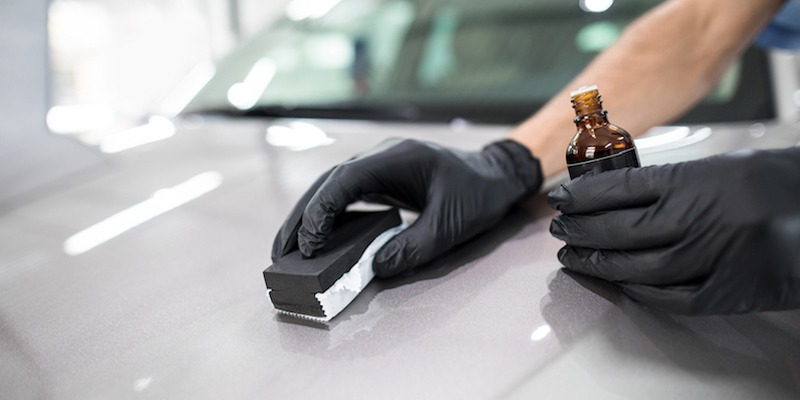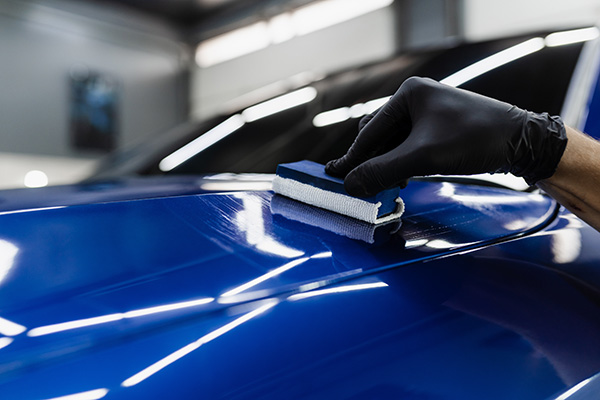How to Prepare Your Automobile for a Professional Ceramic Coating Treatment
Wiki Article
The Significance of Ceramic Coating: Safeguarding Your Cars and truck's Outside With Accuracy
In an era where keeping the aesthetic and functional integrity of your automobile is paramount, ceramic layer arises as a pivotal option. With its special bonding buildings, ceramic finish provides a degree of protection that much goes beyond traditional waxing techniques.Advantages of Ceramic Coating
When it concerns protecting an auto's visual appeal, ceramic finishing uses substantial benefits. This advanced protective layer supplies a sturdy shield versus ecological contaminants, including dirt, gunk, and unsafe UV rays. By creating a semi-permanent bond with the vehicle's paint, ceramic finishes properly prevent oxidation and fading, making sure that the cars and truck keeps a glossy, showroom-like finish for an extensive duration. This not only improves the car's visual allure yet additionally adds to its lasting worth.Along with its protective qualities, ceramic covering supplies impressive hydrophobic buildings, causing water and other liquids to grain off easily. This function streamlines the cleansing procedure, as dust and debris are less likely to follow the surface area, reducing the frequency and effort needed for maintenance. In addition, the layer's resistance to chemical spots from acidic contaminants like bird droppings and tree sap is an additional noteworthy advantage, minimizing prospective paint damage.
Ceramic finishes additionally boost scrape resistance, providing a layer that can take in small abrasions and swirl marks. This quality is particularly valuable in preserving an immaculate surface area, reducing the likelihood of visible blemishes and preserving the stability of the car's paintwork gradually.

Exactly How Ceramic Finishing Functions
Comprehending the mechanics behind ceramic finish exposes its effectiveness as a protective option for vehicles. Ceramic coverings are basically liquid polymer applications that chemically bond with an auto's manufacturing facility paint, producing a protective layer. This layer acts as an obstacle against environmental pollutants such as ultraviolet, grime, and dust rays, which can weaken an automobile's exterior gradually. The essential part in ceramic coating is silicon dioxide (SiO2), which stems from quartz crystals and is known for its exceptional hardness and durability.Application of ceramic finish entails a careful procedure. This shield boosts the automobile's gloss and hydrophobic residential or commercial properties, promoting less complicated cleaning by triggering water and pollutants to grain and slide off effortlessly.
In addition, the finishing's molecular structure gives resistance to small scrapes and chemical stains. Unlike waxes or sealers that rest on top of the paint, ceramic layers integrate with the surface, supplying lasting security. This combination is essential to its performance, making certain the lorry's coating stays excellent for years.
Comparing Ceramic Coating to Alternatives
In the realm of automobile security, ceramic finish stands as an awesome alternative when contrasted to typical options such as sealers and waxes. While waxes offer a momentary glossy finish, commonly lasting just a few weeks to months, ceramic coverings supply a longer-lasting service, commonly withstanding for many years. This durability is credited to the chemical bonding that occurs when ceramic coatings are applied, developing a strong layer that is resistant to ecological dangers.
Contrastingly, sealants, although more resilient than waxes, still drop brief of the durable protection supplied by ceramic finishings. Sealers can generally last for up to a year, supplying a synthetic guard versus particular aspects. They do not have the exceptional hydrophobic residential or commercial properties and UV defense that ceramic coatings supply.
In addition, ceramic finishes use enhanced scratch resistance, which neither waxes neither sealants can successfully match. In summary, while traditional waxes and sealants provide fundamental protection, ceramic coatings offer a thorough, long-lasting remedy that considerably improves and protects the vehicle's outside coating.
Application Process Explained
Using ceramic coating to a vehicle needs a precise procedure to ensure optimal outcomes and toughness. Once cleansed, the car is dried out and polished to eliminate any kind of flaws, as any kind of existing scratches or swirls can end up being a lot more noticable after the layer is used.Following surface prep work, the application of the ceramic coating begins. my latest blog post The finishing is generally used in a climate-controlled atmosphere to avoid dust fragments from picking the newly cleaned surface area. Utilizing an applicator pad, the ceramic coating is applied in small sections to guarantee also protection. It is vital to follow the manufacturer's guidelines relating to the ideal healing time and application density.
After application, the finish needs a specific curing period, throughout which the automobile ought to be safeguarded from water and impurities. This healing procedure can vary relying on the product however usually ranges from 24 to 48 hours. Inevitably, this thorough procedure is pivotal in achieving a resilient and shiny surface.
Upkeep Tips for Longevity
To keep the longevity of a ceramic layer, adherence to a self-displined upkeep routine is necessary. Avoid automated car cleans, as their rough brushes can endanger the layer's integrity.Post-wash, drying out the automobile with a tidy microfiber towel protects against water areas that may weaken the layer with time. Furthermore, use a ceramic coating booster every few months. These boosters strengthen the hydrophobic residential or commercial properties and improve the covering's protective abilities, ensuring it stays effective against contaminants.
Bear in mind that car parking areas play a critical function in Home Page maintenance. ceramic coating. Whenever feasible, park in shaded locations to lessen UV direct exposure, which can gradually compromise the finish. For lasting storage space, think about making use of an auto cover for included protection versus environmental elements
Final Thought
Finally, ceramic layer works as a vital safety layer for automobile exteriors, offering resilient defense against ecological aspects such as dirt, uv, and grime rays. By creating a semi-permanent bond with the paint, it improves aesthetic charm while maintaining the vehicle's value. Its hydrophobic homes facilitate simpler maintenance, identifying it from alternative protective methods. Recognizing the you can try this out application process and adhering to maintenance suggestions are vital for maximizing the durability and performance of ceramic coating.When it comes to preserving a vehicle's visual allure, ceramic covering offers substantial benefits. By developing a semi-permanent bond with the car's paint, ceramic coverings efficiently avoid oxidation and fading, making sure that the vehicle preserves a glossy, showroom-like coating for a prolonged duration. Ceramic layers are basically fluid polymer applications that chemically bond with a vehicle's factory paint, creating a protective layer. In recap, while standard waxes and sealers use standard security, ceramic finishes provide a comprehensive, long-term option that considerably protects the car and boosts's exterior finish.

Report this wiki page